
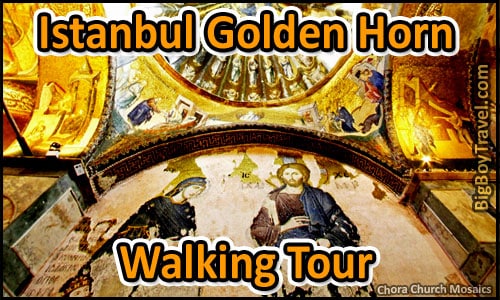
Istanbul Golden Horn Walking Tour:
Location: Golden Horn (Haliç)
Start: Eminönü Duragi Bus Station
End: Fener Duragi Bus Stop
Walking Distance: 2 miles after bus ride (bus schedule)
Time: 20 Minute bus ride, 1 hour walk (4-6 hours with all sights).
Best Time To Go: Any day but Wednesday when Chora is closed.
Fun Scale: 8 out of 10
The Golden Horn is a hidden gem of Istanbul that most tourists miss out on. This historic inlet off of the Bosphorus Straight became so important to early Istanbul’s shipping and commerce that it quickly got the nickname Haliç, or Golden Horn. As the City expanded past its original walls, grand Palaces and Churches sprung up on the edges of town including the Golden Horn. Many of these structures were World wonders when they were built and still wow visitors to this day. Our suggested walking tour takes you between holy Christian and Islamic sights while also winding through brightly colored Jewish neighborhoods. You will love our self guided Golden Horn walking tour!
Golden Horn Walking Tour Sights:
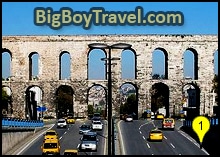
1. Valens’ Aqueduct (Bozdogan Kemeri): Completed by Emperor Valens in 368A.D., this sturdy Roman aqueduct helped bring water in from as far as 12 miles away. The two story, arched structure was instrumental in filling the city’s underground cisterns which not only helped Constantinople to grow, but also protected it in times of drought. You can see how amazing the construction was as a 3,100 foot long section of Valens’ Aqueduct still stands today. At some points, the Roman aqueduct is up to 30 feet wide. There are a number of great vantage points to view Valens today but the best by Atatürk Bulvarı Street which passes right through it. As your bus approaches the aqueduct it’s really cool that the lanes split to go around Valen’s pillars. If you are really ambitious, you can even get off the bus and take stairs on either end of the Aqueduct to climb all the way to the top.
*As you pass by on the bus it is important to known the story behind the historic…
2. Church of the Holy Apostles Location: In 330AD Emperor Constantine started to build his new capital city of Nova Roma over the Greek village of Byzantium. Although later called Constantinople, it was important to Constantine that his Nova Roma be built on 7 hills just like ancient Rome was. On the tallest of the City’s original 7 hills, Constantine built the largest Church of the Holy Apostles meant to serve as his own final resting place. The church was designed in the shape of a cross complete with an extravagant mausoleum for the Emperor along with 12 rooms meant to house relics from each of the Apostles. Constantine died just 7 years after founding Nova Roma, but his sons kept the projects going. One of the sons Constantius II secured relics Andrew, Luke, and Timothy to honor his father. Constantius II also completed his dad’s Great Church (Megale Ekklesia) in 360AD which sat where Hagia Sophia is today.
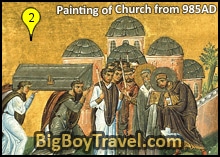
To make his own stamp on the history, Emperor Justinian I later rebuilt the Church of the Holy Apostles in 550AD as a mega structure that became World famous overnight. Justinian had just completed building the mighty Hagia Sophia (Church of Holy Wisdom) and carried the same cascading domes over to Church of the Holy Apostles. While retaining the cross layout, a series of 5 domes made the Church so impressive that Orthodox Church decided to make it home of their Patriarchate, who was the equivalent of their Pope. This was big news for Constantinople as Hagia Sophia also became the center of the Holy Roman Empire. The new Church of the Holy Apostles’ cross shape later served as a model for St. Mark’s Church in Venice Italy and for the Basilica of St. John in Ephesus Turkey which was built over the burial site of John the Apostle. Faithful would pilgrimage to the new Church of the Holy Apostles from great distances and it’s said that it even ended up also being the inspiration for St. Peter’s Church in Vatican.
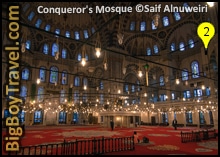
The mausoleums at the Church of the Holy Apostles continued to hold the remains of each Byzantine Emperor and their family through Constantine VIII in 1028 when they basically ran out of room. The grand Church was later hit hard by the Crusades of 1204 when raiders took most of the treasures from it and Hagia Sophia, sending the trove to St Mark’s in Venice where much of it remains today. The biggest hit came when Sultan Faith Mehmet II conquered Constantinople in 1453 and tore it down to build a mosque to revival Aya Sophia. The Grand Mosque never hit the status he hoped and collapsed after just 50 years in an earthquake. When the current mosque was built in 1771 it was named the Conqueror’s Mosque (Fatih Camii) after Sultan Faith Mehmet II who’s tomb sits inside. As you pass by the outside, notice the Faith Monument which depicts Sultan Faith Mehmet II victoriously riding a horse into Istanbul which he conquered in 1453. There are no visible elements from the Church of the Holy Apostles visible at the site today, but there is a street market here on Wednesdays.
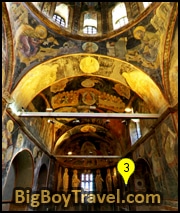
Mosque Visiting Hours: Open daily one hour after sunrise until one hour before sunset. Closed to tourists starting 30 minutes prior to each of the 5 daily prayer times until the service it over. Services last around 30 minutes, but the Friday mid-day sermon may last a full hour. Best Time To Go: Typically between 9am and Noon as it is the largest gap between services. Here is a helpful list of current prayer times for Istanbul day by day to better help you plan your time. You will need to remove you shoes on entry and be modestly dressed. Women will also have to cover their hair. Cost: Free. 360 Degree Tour: (Conqueror’s Mosque).
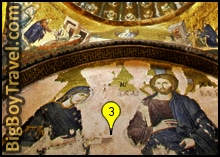
3. Chora Church (Kariye Muzesi): Chora Church, known for its amazing mosaics, is by far the highlight of Western Istanbul. The Church was first built as a simple chapel outside of the city walls in the early 5th Century. Because it was built here locals called the church Kariye (in Turkish) or Chora (in Greek) meaning “outside of the city”. As Emperor Justinianus built his summer residence Palace of Blachernae nearby, he replaced the small chapel with the first Chora Church here. As later Emperors spent more time in Palace of Blachernae, Chora Church began to serve as the court chapel for many important religious ceremonies.
In 1204 Crusaders overtook the city and greatly damaged Chora during a 57 year occupation. After the Byzantines reclaimed the city, Emperor Theodore Metochites renovated and expanded the church including efforts in 1313 when the entire interior was completely covered with beautiful mosaics and frescoes. The mosaics and frescoes in the Chora were considered one most beautiful examples of Byzantine art ever made and shows scenes from both the Bible and Torah along with the life story of Virgin Mary from apocryphos which isn’t part of the Bible.
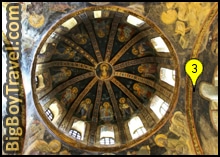
Even after the Ottomans conquered the city in 1453, Chora continued to serve as a Christian Church for almost 60 more years until being turned into a mosque in 1511. While converting the church into a mosque, the Ottomans added minaret tower outside, moved the main prayer niche off center, and plastered over all of the mosaics. The prayer niche had to be moved off center during the conversion to face Mecca since the original Christian church was built pointing toward Jerusalem.
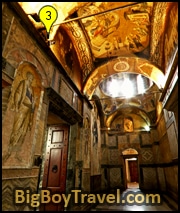
Chora Church remained a mosque through the Ottoman Empire and into the modern times until being converted into a museum in 1945 by the Byzantine Institute of America. During an initial 13 year restoration of Chora, the thick layer of plaster on the walls was removed uncovering the hidden treasure of the 14th Century mosaics and frescoes. Some were damaged, but you’ll be amazed at how well preserved, beautiful, and detailed the over 50 remaining mosaics and frescoes are. The museum has a great brochure when you arrive with a very detailed map highlighting each mosaic and fresco with descriptions on what each one depicts. Doing the Chora Church walking tour yourself without a guide is fine as their brochure points out and explains a lot of what you’ll see.
Getting Here: Take Bus #91O or #32 from Eminonu Bus Station or Bus #87 from Taksim Square. You will get off at the Edirnekapi Bus stop just a brief walk from the South of Chora Church. This but stop is just after you pass the sunken stadium to the North. Taxi is another option and only about 15TL from Old Town. 360 Degree Tour: Here. Hours: Thursday-Tuesday 9am-4:30pm, open until 7pm April-October, Closed on Wednesdays. Ticket sales end 30 minutes before close. Cost: 15TL.
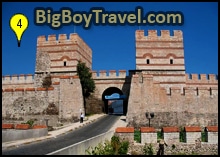
*From the West side of Chora Church it’s easy to spot and walk toward the 65 foot tall towers of the 4 mile long…
4. Theodosian City Walls: By the 5th Century, Constantinople had already largely outgrown the Wall of Constantine built around the city 100 years before and badly needed a new defense. To better enclose the ever expanding city, the Theodosian Walls were built roughly 1.3 miles further to the West of the old Wall of Constantine which almost doubled the size of the city. The 4-mile-long Theodosian Wall stretched from the Blachernae Palace complex in the North all the way to the Golden Gate, known to them as the Seven Towers (Yedikule) to the South.
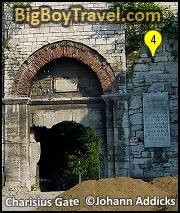
Land walls were always built more stout than sea side walls, but the Theodosian Wall were built so over the top they were almost un-breachable. On the outside of the Theodosian Wall was a 25 foot deep and 60 foot wide moat with its own 6 foot tall wall, then came a 61 foot wide raised terrace called Parateichion, a 26 foot tall inner wall at the edge of the terrace that was up to 6 feet wide, then a 55 foot wide trench called Peribolos, and finally followed by a massive 15 foot wide inner wall that had 185-65 foot tall towers and a few heavily guarded gates! Here is a great cross section drawing of wall looked like at its peak.
Over the final 1000 years of the Byzantine Empire, the Theodosian Walls held up great and invaders only got into Constantinople twice. The first group to do so were the Catholics during the 4th Crusade in 1204AD who used ladders to get over part of a sea wall and broke through a part of a smaller wall to the North. These Crusades occupied Constantinople for a 57 years considered to be the Latin Empire until the Byzantines reclaimed the city.
After the Crusaders were kicked out, the next group to breach the city were the Ottomans in 1453 who basically walked right in. The Ottomans had been building forces on the edges of Constantinople for over 150 years, but got some inside helped toppling the city. In an act of treason someone left the Adrianople Gate, which opened right onto the main Southern road, wide open for the Ottomans. They were then able to attach from both sides of the wall and the Byzantines quickly gave up. After the conquest, the Ottoman’s leader Sultan Faith Mehmet II rode victorious through Gate of Charisius which sights straight West of Chora Church. In those days the gate was on the main Northern road on of Constantinople called Fevzi Pasa. Look for the restored gateway as you approach the wall which has plaque signifying its importance. Also look for stairs next to and inside each tower you pass if you want to scale to the top of the ancient wall.
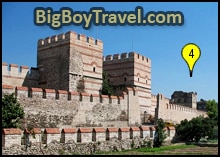
*Following the wall North it’ll be impossible to miss the 3 story tall ruins of the…
5. Palace of the Porphyrogenitus (Tekfur Sarayi): In 1081, the Byzantines decided to move their full-time royal palace from the Grand Place (where the Blue Mosque now sits) to the Summer residence of Blachernae Palace. When you move into your Summer residence full-time of course you need to build a new Summer getaway which ended up being the Palace of the Porphyrogenitus.
Although it’s now known as Tekfur Palace today, the Palace of the Porphyrogenitus. The Palace of the Porphyrogenitus was a perfect Summer hideaway as its 3 stories led to great city views, and it was only a couple blocks to the South of the main Blachernae Palace. The Byzantines got just over 100 years of use out of the Palace of the Porphyrogenitus before the Ottomans conquered Constantinople. Once in power, the Ottoman Sultans never lived in the Summer Palace and only used it to keep their collections of exotic animals. Today the wood roof and interior are long gone, and there is often trash scattered around, but the Palace ruins give you a great peak into Byzantine life. 3D Render of Tekfur Palace: Here. Hours: Daily 9am-7pm, sometimes closed for restoration. Cost: 3TL.
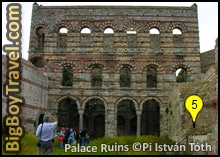
*As you move on from the Palace ruins, stay on the road that runs right along the wall. The road will turn to the left then to the right to follow the path of the wall and in a couple blocks brings to the Eğrikapı Gate, also called the Bent Gate. This small gate serves as a passage way for Eğrikapı Street to cross the wall and also leads to the very interesting…
6. Sahabe Cemetery (Sur Dibi): The small Sahabe Cemetery just outside the Eğrikapı Gate may seem like a standard Muslim cemetery, but there is a reason why so many tours visit Sahabe each day. Two separate times (674–678AD & 717-718AD) large unsuccessful Arab Sieges on Constantinople happened mainly led by direct companions of the Prophet Muhammad called the Sahabe. Many Arab soldiers and Sahabes were killed in these failed Sieges and it wasn’t until 1453 when the Muslims of the Ottoman Empire finally overtook the city. To put the Sahabes into context, Muhammad companions are the Muslim equivalent of the Christian Apostles who followed Jesus.
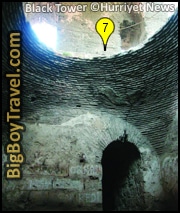
After finally gaining Muslim control of the city in 1453, Sultan Faith Mehmet IIsought out the grave sites of Muhammad’s fallen Sahabe to honor them. Sultan Mehmet ended up finding many of the Sahabe tombs in the cemetery near Eğrikapı and added the phrase Sahabe-den to their head stones to mark their importance. Check out a few tombs and see if you can find any Sahabe-den inscriptions.
If you haven’t already gotten a good view of the outside of the walls, this would be a great time to do so. It only takes walking about 100 yards into the small park just South of the Cemetery across Eğrikapı Street to get the view of what invaders were up against as they closed in on the imposing wall.
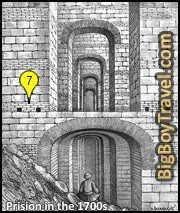
*After you go back through Eğrikapı Gate to the city side of the wall, follow it further North to the Kazasker İvaz Efendi Mosque. From the open back courtyard of the mosque you conveniently sit on a bench and gaze at the…
7. Anemas Dungeon (Anemas Zindanı): Located on the back of the grounds for Ivas Efendi Mosque, the ruins of Anemas Dungeon are all that remain from the Blachernae Palace complex. The Palace complex was built in the 6th Century and served as a Summer residence for Byzantine Emperors until it became the full-time main Palace in 1081. The Dungeon gets its name from a Arabian commander imprisoned here named Michael Anemas who was had tried to assassinate the Byzantine Emperor in 1107. While Anemas served jail time, he was spared execution because of pleas from the Emperor’s daughter who was in love with him. The 14 cell above ground prison tower continued to see lots of action over the years but it was the dungeon below your feet where the really nasty stuff happened. Catholic Crusaders overtook the city during the 4th Crusade in 1204 and held 6 different Byzantine emperors here over a 57 year occupation. In the dungeon the Emperors were held, tortured, blinded, mutilated, and eventually killed.
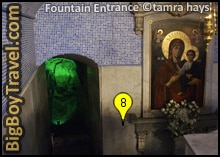
Today you can still see the main 14 cell tower of the prison, and even climb to the very top, but the guts have all collapsed leaving only a hollow shell where the cells once were. If you really want a cool experience we recommend bringing a flashlight and checking out the labyrinth of tunnels of dungeon tunnels that lie beneath your feet. The gate leading into the dungeons near the Garden is typically open during the day and has been used in scenes of many Turkish movies. Word of Caution: While the dungeons are a treat, use some caution as there are some times broken bottles and there is no security staff monitoring the tunnels. We’ve never heard of anyone having problems with homeless people, ect, but you’re probably better off being smart and not going in alone just in case.
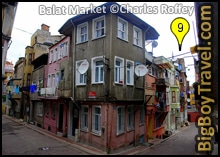
8. Virgin Mary Holy Spring (Ayazması Meryem Ana): The Church of St. Mary of Blachernae once numerous relics of the Virgin Mother Mary including what was believed to be her actual scarf. These relics were often put on display during the early years of the Byzantine Empire to provide protection to the city. Although the relics are long gone, inside the church grounds is a spring that is believe to run Holy Water that will give you good luck and health if you drink from it. It’s pretty easy to find the spring inside as many superstitious locals bring their water bottles here to fill up, feel free to do the same and see if your luck changes. Even if you don’t have a change of luck at least you’ll be able to say you tried and you’ll also have a bottle of nice cold water. Although it is an Orthodox church we’ve always seen a lot of local Muslim women here who are also superstitious and seek out church to get rid of curse people put on them.
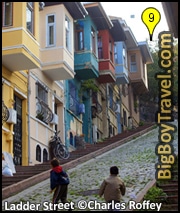
*From the Spring, either walk or take the Bus 99/399 right to the colorful…
9. Balat Jewish Neighborhood: In a city filled with beautiful photo opportunities and amazing visuals, the lively Balat neighborhood. This neighborhood was the primary home to Istanbul’s Jewish community from the 1400s through the early 1900s. The biggest influx came when 200,000 Jews were kicked out Spain when Christian rulers took over in 1492 and expelled them. Spain’s Moorish rulers had previously let the Jews live freely and the Ottomans followed suit opening welcoming the them to further establish the Balat neighborhood. The area quickly grew and at one point the area held almost 20 Synagogues, although only a couple still remain. The heyday of Balat was the 1600-1800s when Jewish merchants built up every square inch of the neighborhood into a tightly fitting labyrinth of streets that became known as Balat Market.
Today many of the rich Jewish people have moved further into the suburbs and the neighborhood has become a colorful melting pot of cultures. Right as you enter Balat you’ll pass by a Mosque, Christian Church, and Synagogue all in a row within 1000 feet of each other. Clotheslines are strung building to building over cobblestone streets and a kaleidoscope of colors peer from behind grungy exteriors. The very 1st street (Hizir Çavus Köprüsü Sok) gives you a great look at the tightly packed 3-4 row houses Balat has to offer but even better is to come. Keep walking through town until you hit Çorbacı Çeşmesi Sok which houses the best sights the neighborhood. Follow the colorful homes and make sure to pop down the dead end Hızır Çavuş Mescidi Sokak to see a wonderful wooden mansion.
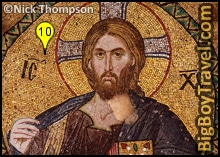
On the next block over, the wooden Balat Café (website) marks the entrance to the colorful homes of Ladder Street (Merdivenli Yokuşu). This is a great spot to take a rest, get some tea and a little traditional food to refuel. With food in your belly is time to start the up hill trek up Ladder Street which is a favorite with tour groups. It is east to think of San Fransisco’s iconic sister houses as you work up the street so steep it needed 2 sets of steps. Overall the entire neighborhood is a magical experience, especially for photographers. Balat Cafe Hours: Daily 9am-11pm.
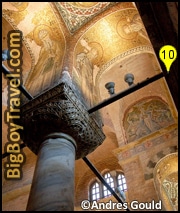
*If you really loved Chora Church then consider the uphill hike to the ancient mosaics at…
10. Pammakaristos Church (Fethiye Camii): A basic church was here as early as 1071AD and replaced with the timeless Pammakarístos Church in 1292AD. Some of the amazing tiled mosaics inside the old world Church are so grand that they were finished until 30 years after the Church itself was. After the demise of the Holy Church of the Apostles, Pammakarístos served as the head of the Greek Orthodox from 1456 to 1587 before being converted into a mosque. A lot of the interiors walls were removed during the conversion, but some of the best ceiling mosaics were kept and just covered up. Restoration began in the 1940s when, just like Chora Church and Aya Sophia, they found beautiful mosaics and frescoes behind layers of plaster. Of the many huge mosaics, our favorites are of Christ with the Apostles under the central dome and another on the wall showing the Baptism of Jesus. Hours: Tuesday-Sunday 9:30am-4.30pm; Closed Mondays. Cost: 5TL.
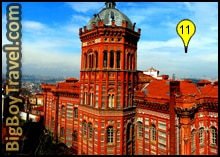
*From Pammakarístos, wind over the tallest point in the Fener Greek Neighborhood to the…
11. The Red Castle School: Known as the Red Castle, the Phanar Greek School for Boys, towers like a citadel over the Fener Greek Neighborhood. The the 600s one of the Byzantine Princesses built a nunnery here which later became the Church of St. Mary of the Mongols in the 1200s. The neighborhood children started taking lessons at the church, and withing 200 years an official school was running. The biggest expansion came in 1881 when the giant castle school was built which today houses full K-12 education. The original St Mary’s Church still exists next to the school, but it and the Red Castle are typically closed to the public. Even though you can’t go inside, the views looking back up as it as you head toward the Golden Horn are very impressive.
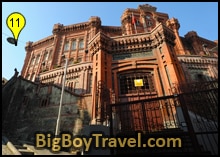
*Heading down the hill puts you right in the middle of the…
12. Fener Greek Neighborhood: The Fener neighborhood feels a lot like Balat but with Greek instead of Jewish origins. Greeks starting coming to Constantinople over 1,000 years ago while the Byzantines controlled the Aegean Peninsula. Istanbul became the center of the Eastern (Greek) Orthodox Religion early on which brought in not just pilgrims, but also settlers from Greece and Armenia. The Ottomans took Greece from the Byzantines in the 1300s before later taking everything else including Istanbul. The dual influence led to the establishment of a formal neighborhood that over the centuries has become more Orthodox than it has become ethnic Greek. Fener sprung up as much more of a working class neighborhood than Jewish Balat did, but it is still just as beautiful. Among off of the streets our favorite is Sancaktar Yokuşu which leads from the Castle School to the Golden Horn. Halfway down the street, it splits right in the middle forking around an amazing cluster of homes known as the Blue Corner. Get your camera ready.
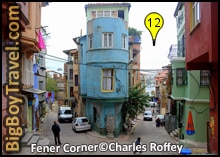
13. Church of St. George (Ecumenical Patriarchate): For the last 400 years, the Church of St. George has been the ongoing seat of the Ecumenical Patriarchate of Constantinople, who is in charge of the Greek Orthodox Church and recognized as the spiritual leader of the World’s Eastern Orthodox Christians. In plain talk St. George is basically the ‘Vatican’ of all the Eastern Orthodox religions. Aside from pilgrims many foreign dignitaries also make a stop at St George.
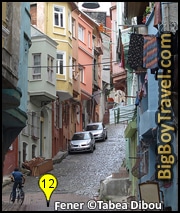
This very important Church of St. George may seem quaint from the outside, but it’s both charming and powerful on the inside. There is gold everywhere inside, from the mosaics on the back wall, to the crosses that pepper the ceiling, but the true gem is the golden altar that covers the entire length of the back wall from top to bottom! Each panel on the golden altar has beautifully detailed paintings of biblical figures but you’ll end up spending so much of your attention on how awesome the altar itself is, it’ll be hard to focus. Once you get you barrings turn around and take in the rest of the cozy church behind you. Two large chandeliers hang above 48 padded and tightly group chairs. Side seating and a small two level balcony only increase the seating from 48 to 200 so service is said to be pretty intimate indeed.
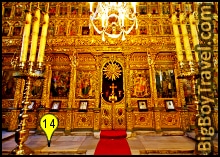
If you are lucky enough to be through mid-morning or afternoon the small windows on the sides of the church create excellent light beams that cast down onto unmarked relics from numerous Saints. Among the relics are two glass cases filled with bones who belonged to St. Gregory the Theologian and St. John Chrysostom, two saints who served as Archbishops of Constantinople in the 5th Century. Pope John Paul VI personally returned a bunch of these artifacts to the Church of St. George as they had been removed from Istanbul during the 4th Crusade in 1204. The gate outside was welded shut in 1821 as a show of sorrow for Gregory V who was hung to death at the gate by the Ottomans. Church Hours: Daily 8:30am-4pm. 360 Degree Tour: (Interior).
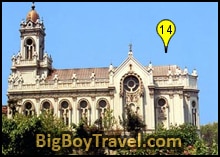
14. St. Stephen of the Bulgars Chruch (Sveti Stefan): This Bulgarian Orthodox Church looks like it was made of stone but is actually made up from cast iron sections forged in Vienna then shipped down the Danube on over 100 barges. The 500 tons of precast iron pieces arrived in 1871 and was quickly put up and bolted together. The craftsmen ship is definitely worth a stop if you are getting through your stops quickly. During the day either the caretaker or his kids are available to meet you at the gates and show you around. Church Hours: Open almost every day 9am-4:30pm, may need to find the caretaker to be shown around which is easy. Cost: Free, but we recommend leaving a couple TL since they are taking the time to show you around
*Bus 99 and 399 can take you further up the Horn to the Holy Islamic sight of the…
15. Sultan Eyüp Mosque & Tomb: This mosque was built over site of the tomb of Sultan Eyüp who led the Arab Siege on Constantinople in 674A.D. Eyüp’s death was a major blow to the Arab invaders as he was considered the last living Sahabe, or companion of the Prophet Muhammad. Although the 674 Siege failed, preservation of Eyüp’s tomb was worked in as part of the peace treaty. When the Ottoman’s finally overtook Constantinople in 1453 the Sultan had the mosque built over Eyüp’s tomb which he also had turned into a silver sarcophagus. Although the mosque had to be rebuilt after a 1766 earthquake, Eyüp Sultan Mosque is still considered one of the holiest Muslim spots in Istanbul and brings in many pilgrims.
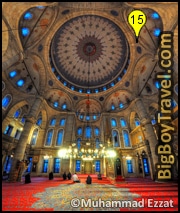
Getting Here: From the Ayvansary Bus Stop, take Bus 99, 399B, or 399C West to the Teleferik Stop then walk 100 yards South right to it. Buses 55T & 99A also go to the Zalpasa Bus Stop from Ayvansary right on the Southern corner of the Mosque. Hours: Daily 9am-6pm.
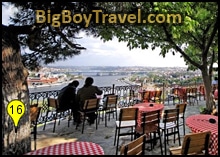
*Take the cable car high above the Golden Horn to the…
16. Pierre Loti Café (Kahvesi): As you get to the top of the Teleferik Cable Car, the view of the elevated view of the Istanbul is amazing. Make sure the notice the Ottoman-era graveyard halfway up the hill, and consider walking through it on your way down. The upper terrace is perfectly placed to overlook the Golden Horn below and it even has a great cafe with open air seating. The Pierre Loti Cafe if has been a favorite among locals for hundreds of years.
The Cafe is named after the former French Naval Officer and author Pierre Loti (pen name was Julien Viaud) who frequented the Cafe. As a writer Loti as considered the finest descriptive author of the late 19th Century and often gained inspiration while relaxing on the terrace overlooking Istanbul below. His most famous book Aziyadé, was a semi-autobiographical tale of how he fell in love with a 18-year-old from the Sultan’s Harem while in Istanbul named Aziyadé. Loti won of the hearts of many Modern Turks by being an outspoken supporter of the 1920’s Turkish War of Independence against the Ottomans. Getting Here: Take Bus 99, 399B, or 399C to the Teleferik Stop. From here the quick cable car up is only 2TL, otherwise it’s a 30 minute walk up. Last cable car returns down at 11pm. Cafe Hours: 8pm-Midnight, Terrace opens at Dawn.
Other Sights Near The Golden Horn:
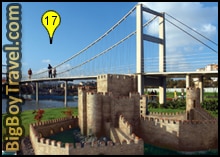
*Sitting at the very end of the Golden Horn is a great family attraction…
17. Miniaturk (Minyatür Türkiye Parkı): A family-friendly favorite, Miniaturks’ 4.5 acres make it one of the biggest miniature parks in the World. The main highlight of the park are the 120 models of famous buildings and structures all built in a 1/25th of actual size. The Miniaturk models trace a 3,000 year history of the Turkish people from Antiquity to Byzantium, from Seljuks to the Ottoman Empire and into the present day. Among the 120 miniatures are 57 structures from Istanbul, 51 from the Asian side of Turkey (Anatolia) such as Ephesus, and 12 from former Ottoman territories that today lie outside of present-day Turkey.
The park does a great job of using three main walk ways and landscaping to separate the different regions the models represent and everything flows really well even if the park is super busy. Because all of the models are 3D, you are going to have many great vantage points to further investigate any of them that catches your eye. Here is a handy list of images and descriptions right from the park’s brochure to help you get a better idea of what you will see. Hours: Daily 9am-7pm. Cost: 10TL. Getting There: You can either take a taxi directly there or Bus 399B to the Sünnet Köprüsü right by the park. You can also take either bus 399C, 39, 39B, 39C, 39D, 39Y or 99 to the Sakarya Mahallesi stop which is only a short walk to the park.
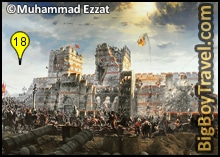
*If you liked the walls and want an amazing visual experience make sure the check out the…
18. Panorama 1453: Located at the sight of the Topaki Siege of 1453, this was the largest of the battles between the Byzantines and invading Ottomans. The installation is a huge dome painted floor to ceiling with a 3D illustration of a scene from the battle. You are lead in by the music of a Janissary Band while sounds of fire and cannons go off all around. To top it all off the floor is filled with props like barrels and cannons making it hard to figure out where the props end the the 3D painting begins. It is an amazing experience. Hours: Daily 8am-6pm. Cost: 5TL.
Golden Horn Bus & Ferry Transportation Tips:
Golden Horn Buses Overview: Off of the buses in Town cost only about 1.5TL per ride, so they are pretty cheap and will save you a bunch of walking. They also come often with each line running 2-5 times per hour. The Green Route on out map marks the route for Buses 87, 32, & 91O. 87 Starts at Taksim Square and the others start at the Eminönü Bus Stop near Galata Bridge. The Purple Route marks the route for Buses 99, 399B & 399C. 99 will go all the way back to Eminönü Bus stop, but the other two drop you off slightly to the West. The Buses typically run from 6am-Midnight.
Detailed Bus Routes:
Bus 32: EMİNÖNÜ-CEVATPAŞA http://harita.iett.gov.tr/en/?hat=32
Bus 91O: Same stops as 32 http://harita.iett.gov.tr/en/?hat=91o
Bus 39: Starts at the Grand Bazaar and goes all the way to Miniaturk with stops at Chora and Telefrik http://harita.iett.gov.tr/en/?hat=39
Bus 39B & 39Y: Both starts at the Istanbul University and goes all the way to Miniaturk with stops at Chora and Telefrik http://harita.iett.gov.tr/en/?hat=39b
Dividing Your Time:
The best sites are Chora Church and colorful neighborhoods of Balat & Fener. On Wednesday when Chora is closed the other sites right around it can be skipped. Kariye Muzesi) (KAH-ree-yeh).
The buses we suggest below run very frequently, but for an up-to-date schedule view the IETT Bus website here.




